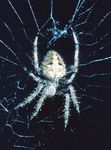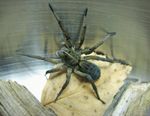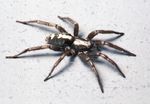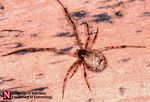Common Spiders In and Around Homes
←
→
Page content transcription
If your browser does not render page correctly, please read the page content below
Common Spiders In and Around Homes
Spiders are as familiar and well known to most people as they are disliked. The
unpopular reputation of spiders is undeserved. Myths about spiders and the negative
consequences of biting by a very, very small number of species overshadow the
ecological benefits spiders provide. All spiders are beneficial predators that feed on
insects, spiders, and other arthropods, and thus help reduce pest populations in and
around homes, landscapes, gardens, and crops.
Characteristics
Spiders are related to insects but are distinctly different. Spiders and insects are both
arthropods; that is, animals with an exoskeleton (their skeletons are on the outside of
their bodies) and jointed legs. Differences between spiders and insects are described
in the accompanying chart. Spiders are closely related to mites, ticks, and scorpions
and are collectively known as arachnids.
Comparison between spiders and insects
Spiders Insects
Body regions Two Three
(cephalothorax, abdomen) (head, thorax, abdomen)
Legs Eight Six
Eyes Simple, usually eight (rarely six) Compound, two
Wings None Four (sometimes two or none)
Antennae None Two
Mouthparts Chelicerae (fangs) Mandibles (jaws)
All spiders produce silk throughout their lifetime. Silk is produced as a liquid in
specialized structures called spinnerets located at the tip of the abdomen. Silk hardens
as it is drawn from the spinnerets and has contact with the air. Spider silk is used
to build webs and other types of snares that capture prey, and to make egg cases,
draglines, shelters, and retreats. Silk produced by spiderlings (young spiders) enables
them to be transported by air currents and wind in a process called ballooning.
Spiders are predators feeding mainly on living insects, mites, and other small arthropods.
Spiders are considered beneficial because of the large number of insects they prey
on, including a number of pest species. All spiders have venom that is injected through
the hollow fangs (chelicerae) into the living prey to immobilize the prey and begin the
digestion process. Spiders feed by liquefying the prey with digestive fluids that are
injected or regurgitated into the prey and then sucking in the digested food.
University of Wisconsin–Extension
PM 1722 Revised February 2012 A2135 FO-1033-B
1Spider Bites
Spiders very rarely bite people and far less than is generally
assumed. Most spiders are harmless to people and are
incapable of biting, even when coaxed. Most people and
even medical doctors overstate “potential spider bite”
diagnosis based on ambiguous symptoms such as redness,
swelling, cramps, severe pain, or even necrotic lesions that
can be caused by other factors including other diseases or
medical conditions and bacterial skin infections.
For more information on spider bites and dangerous spiders,
see Potentially Dangerous Spiders, A3689-University of
Wisconsin Extension; PM 1721, Iowa State University Extension
and Outreach; WW-06962, University of Minnesota Extension.
Common Spiders In and
Around Homes
(NOTE: Sizes given under spider descriptions represent the
length of the body not including the legs).
HUNTING SPIDERS are outdoor spiders that may
Spider Behavior wander indoors as accidental invaders. Listed below are the
most common hunting spiders that may be found indoors.
Spiders can be divided into two groups depending
on how they capture their prey. Wolf spiders (Figure 1) are moderate to large-sized
• Hunting spiders do not construct webs to capture spiders (1⁄4- to 1-inch long) with dark brown and slightly
hairy bodies. Wolf spiders are found on the ground or under
food. Instead, they rely on quickness and relatively
stones in a wide variety of habitats, such as woodlands,
good eyesight to chase and capture prey. Active grassy meadows, beaches, landscapes, gardens, and
hunters (sometimes known as wandering spiders) fields. Some even live underground. They commonly hunt
actively search for and chase their prey. Passive during the day or at night when it is warm. Wolf spiders are
alarming because of their large size and rapid movements.
hunters lie in wait and seize prey as it approaches. They are not aggressive and, according to The Golden Guide
Hunting spiders live outdoors, but may wander to Spiders, they make good pets.
into homes accidentally, particularly in the fall,
Sac spiders (Figure 2) are normally found on foliage or on
but they do not survive well and usually do not
the ground. They are small to medium-sized spiders (1⁄5- to
reproduce indoors. 2
⁄5-inch long) and are usually yellowish or light-colored. Sac
• Web-building spiders construct webs in calm, spiders hunt at night, feeding chiefly on small insects, and
hide during the day in a silken tube or sac, from which they
undisturbed places to capture their food. They
take their name. They do not construct webs. Outdoors,
live in or near their web and wait for food to they usually roll up leaves into a tube, or may construct a
come to them. They generally have poor eyesight retreat under stones. Inside buildings, sac spiders are found
in retreats in a variety of places, including high up on walls
and rely on sensing vibrations in their web to
near ceilings.
detect prey.
Fishing spiders (Figure 3) are typically seen near ponds,
swamps, or slow-moving streams, but some may be found at
considerable distances from water. Fishing spiders are the
largest spiders in the Upper Midwest (1-inch long). With legs
2Figure 1. Wolf spider Figure 2. Sac spider Figure 3. Fishing spider
spread out, some fishing spiders cover as much as 4 inches. They are generally
dark-colored, usually brownish or grayish, with white markings. Fishing spiders
can “skate” across water and can dive underneath to capture prey. In addition
to insects, fishing spiders also can catch tadpoles, small fish, and other small
vertebrate animals.
Sowbug spider, also known as the woodlouse hunter or the dysderid spider,
is an introduced species that is now common and widely distributed in the
United States (Figure 4). This medium-sized spider has distinctive coloration: the
Figure 4. Sowbug spider
cephalothorax is purplish-brown, the abdomen is grayish-white, and the legs are
orange. Unlike the majority of spiders, the dysderid spider has only 6 eyes. The
chelicerae (fangs) are quite large and project forward. Dysderid spiders wander
at night in search of food and are ground-dwellers commonly found under rocks
and debris. As the name implies, their preferred prey are sowbugs and pillbugs,
though a variety of prey may be taken.
Jumping spiders (Figure 5) are compact, medium-sized spiders that get their
name from their ability to leap on their prey, often jumping many times their own
body length. They are active during the day and are often found on windows,
ceilings, walls, and other areas exposed to sunlight. Jumping spiders are Figure 5. Jumping spider
compact, small to medium-sized (about 1⁄4- to ½-inch long) and dark-colored with
white markings. Some can be brightly colored, including some with iridescent
mouthparts. These spiders move quickly in a jerky, irregular gait and can run
sideways and backward. The two middle eyes of jumping spiders are particularly
large and jumping spiders have the best vision of spiders, seeing objects up to
eight inches away.
Parson spider (Figure 6), one of the gnaphosid spiders, is a medium-sized
spider (1⁄2-inch long) with a brownish body and gray abdomen with a white band
running down over half the length of its abdomen. Parson spiders actively hunt at Figure 6. Parson spider
night and chase their prey. During the day, they are usually found outdoors under
stones or loose bark in silken retreats. Indoors, they hide under objects or in
cracks or crevices.
Crab spiders (Figure 7) are small to medium-sized spiders (1⁄10- to 2⁄5-inch long)
ranging in color from yellow or red to brown or gray. The first four legs are longer
than the back four and are held out to the sides giving a crab-like appearance.
They can walk forward, sideways, or backward. Crab spiders are passive
hunters — they wait motionless and ambush insects that pass by closely.
Outdoors, crab spiders are often found on flowers but are also seen on stems
Figure 7. Crab spider
or leaves. They are rarely found indoors.
3Figure 8. Cobweb spider Figure 9. American house spider Figure 10. Cellar spider
WEB-BUILDING SPIDERS have some species Common orb weaver
that can survive and reproduce well indoors and outdoors. spiders include the black and
yellow argiope (are-JI-o-pee)
Cobweb spiders are members of a large group also spider, the barn spider, and the
called the comb-footed spiders and are very common both marbled orb weaver spider. The
outdoors and indoors. They are small to medium-sized black and yellow argiope
spiders (about 1⁄8- to 3⁄8-inch long) and have a rounded, (Figure 11), also known as the
globular abdomen, small cephalothorax, and brownish or garden spider, is familiar to
grayish color (Figure 8). They are sedentary and construct many. It is large (up to 1-inch
the familiar, irregular, tangled webs for which the group long) and brightly colored black
is named. Webs are built in undisturbed, out-of-the-way and yellow. The Barn spider
places such as wood and stone piles and in quiet areas of (Figure 12) is large (4⁄5-inch long) Figure 11. Black and
yellow argiope
buildings, such as basements. A common type of comb- and yellow and brown in color.
footed spider found indoors is the American house spider, The barn spider is the model for
also called the common house spider (Figure 9). It is grayish Charlotte in E.B. White’s famous
to brownish with chevron-like markings on its abdomen and book, Charlotte’s Web. The
a body length of over 1⁄4 inch. It builds a loose tangle of webs marbled orb weaver spider
(“cob webs”) in secluded and undisturbed areas of the (Figure 13) is a striking spider
house such as basements and crawl spaces. that attracts attention because
of its typical bright orange color,
Cellar spiders, including the long-bodied cellar spiders, though specimens vary from
are common in dark secluded places such as crawlspaces, orange to beige to pale yellow
basements, and cellars (as the name implies). Like the and white.
cobweb spiders, the cellar spiders build a loose, irregular
web in corners near the ceiling or floor. Cellar spiders are Funnel weaver spiders Figure 12. Barn spider
1
⁄3 to 1⁄4 inch long, pale gray to light tan in color and have long produce a flat, horizontal web
delicate legs (resembling the daddy-longlegs). (Figure 10) with a small funnel-like retreat
off to one side. Webs are
Orb weaver spiders are common spiders outdoors in commonly built on the ground,
gardens, fields, and landscapes. They are rarely found around steps, window wells,
indoors. The orb weaver spiders make the familiar “typical” foundations, and low shrubs.
spider web of concentric circles and radiating lines. They Funnel weaver spiders are
range in size from small to large (1⁄8- to 1-inch long) and are generally brownish or grayish
found in a variety of colors, some being brightly colored. Orb with stripes near the head and
spiders have large, swollen-looking abdomens, including a pattern on the abdomen. They
some that are oddly shaped. Despite their large size and have long spinnerets and are
bright coloration, orb weaver spiders are not dangerous. moderate-sized (3⁄4-inch long). Figure 13. Marbled orb
weaver spider
4Figure 14. Barn funnel Figure 15. Grass spider
weaver
A common member of the funnel-web spiders is the barn
funnel weaver (Figure 14). Barn funnel weavers have a
Indoors
pair of dark stripes behind the head and may build webs in Regular housecleaning is very important in the control of
corners and closets indoors. Other common funnel weavers spiders indoors. Large, persistent spider populations indoors
are called grass spiders. Grass spiders (Figure 15), like the indicate the presence of a significant insect population that
name suggests, build their horizontal webs in the short grass serves as their food.
of lawns. They have three light colored and two dark colored • Capture and discard or remove individual spiders that
stripes behind the head. have wandered inside.
• Remove papers, boxes, bags, and other clutter to minimize
Management of Spiders favorable sites for spiders.
In and Around Homes • Remove webbing with a broom or vacuum, and destroy
any egg sacs and spiders that are found. Look especially
Control of spiders is best achieved with an integrated pest around windows, in corners, and in relatively quiet places.
management (IPM) approach that includes multiple tactics
for prevention, exclusion, and population reduction. Since • Sticky traps such as small glue boards or cockroach
the type of spider will determine the necessary control traps can be used to monitor for presence and
actions, start by identifying the spider involved. abundance of spiders. In limited circumstances sticky
traps also may provide some level of control. Place traps
Spiders are not harmful. Tolerance for spiders and simple along walls, under furniture and appliances, and in other
capture and removal are recommended whenever possible. undisturbed locations.
However, dangerous spiders such as the black widow and • Eliminate insects that serve as a food supply, especially
brown recluse, both very rare in the upper Midwest, require when large numbers exist. Check particularly in and under
immediate attention and control. webs to see what insects have been captured.
• Osage orange fruits, also called hedgeballs or hedge
Eradication of all spiders from a home is difficult and apples, are sold in stores and alleged to repel spiders.
unnecessary. Properties located in areas favorable to They are not effective and their use is not recommended.
spiders, such as by rivers, lakes, or fields, are more likely
• You can supplement your sanitation efforts with an
to have large numbers of spiders. Spiders also will be more
insecticide treatment. Lightly apply insecticide to cracks,
numerous in areas with a large supply of insects that serve
gaps, and other places where spiders may hide. General
as a food source for spiders.
treatments on surfaces and fogs are not effective. Most
insecticides labeled for ants and cockroaches are also
Each situation is unique, but the following guidelines
labeled for spiders. These products are commonly found
describe the integrated techniques that can be used to
in ready-to-use aerosol and liquid formulations.
control spiders.
CAUTION: Read all label directions carefully before
buying insecticides and again before using them.
5Outdoors Photo credits
Figure 1
Use the following techniques if accidental invasion by Figure 2
wandering spiders from outdoors is a frequent problem or Figures 3, 13, 14 Phil Pellitteri
to reduce an unacceptable number of spiders around your Figures 4, 5, 6, 12, 15 Jeffrey Hahn
home and prevent spiders from getting inside. Otherwise, Figures 7, 8, 9, 10, 11 University of Nebraska
spider control in the lawn, landscape, and garden is not
recommended because spiders are beneficial and an Prepared by
important component of the ecosystem. Jeffrey Hahn
University of Minnesota
• Remove piles of bricks, firewood, and other debris that Phil Pellitteri
may serve as suitable homes for spiders or move them University of Wisconsin
further from your home. Laura Jesse
• Keep grassy or weedy areas near buildings cut short. Iowa State University
Extension and Outreach
• Trim back shrubs and other plants that directly contact
Donald Lewis
your home.
Iowa State University
• Periodically remove webs with a broom, vacuum, or a
hard spray of water.
• Remove and destroy any egg sacs or spiders that
are found.
• Check to be sure screens fit tightly. Replace any screens
that fit poorly or are damaged.
• Reduce outside lighting to minimize attraction of insect
prey that can encourage spiders. Yellow lights are less
attractive to insects than mercury or sodium vapor lights.
When possible, place security lights on a pole shining
toward a door rather than on the building above the
door. This will reduce attracting insects that spiders feed
on to the building.
• Caulk or seal cracks or gaps around the foundation,
doors, and ground level windows.
• As a last resort, lightly apply a broad-spectrum insecticide
labeled for the exterior of buildings on the outside of your
home to reduce invasion by wandering spiders. Spray
under siding, in cracks and crevices, and other places
where spiders may hide. General treatments on the siding
or other surfaces are not effective. Read and follow all
pesticide label directions.
…and justice for all
The U.S. Department of Agriculture (USDA) prohibits discrimination in all its programs and
activities on the basis of race, color, national origin, age, disability, and where applicable, sex,
marital status, familial status, parental status, religion, sexual orientation, genetic information,
political beliefs, reprisal, or because all or part of an individual’s income is derived from any pub-
lic assistance program. (Not all prohibited bases apply to all programs.) Persons with disabilities
who require alternative means for communication of program information (Braille, large print,
audiotape, etc.) should contact USDA’s TARGET Center at 202-720-2600 (voice and TDD). To file
a complaint of discrimination, write to USDA, Director, Office of Civil Rights, 1400 Independence
Avenue SW, Washington, DC 20250-9410, or call 800-795-3272 (voice) or 202-720-6382 (TDD).
USDA is an equal opportunity provider and employer.
Issued in furtherance of Cooperative Extension work, Acts of May 8 and June 30, 1914, in
cooperation with the U.S. Department of Agriculture. Cathann A. Kress, director, Cooperative
Extension Service, Iowa State University of Science and Technology, Ames, Iowa.
6You can also read



























































